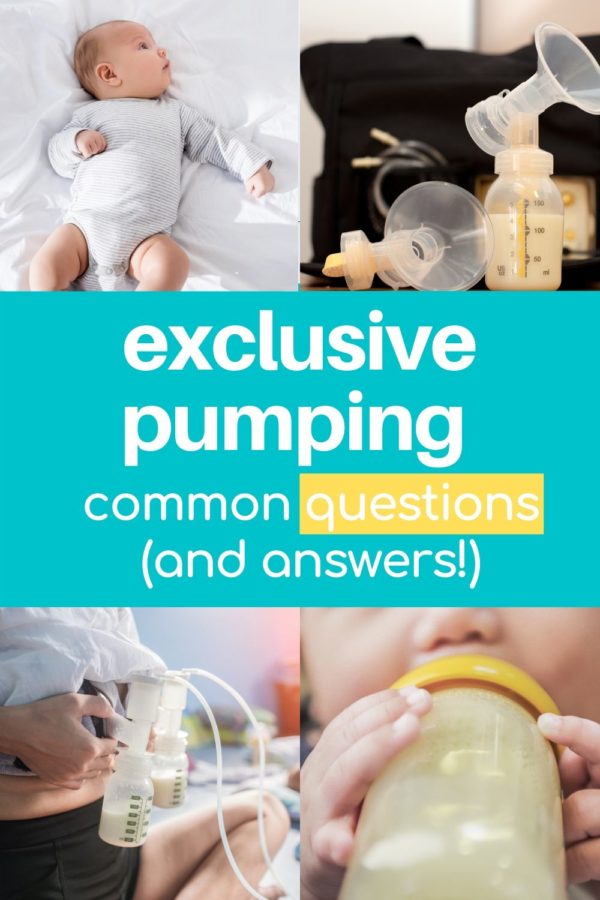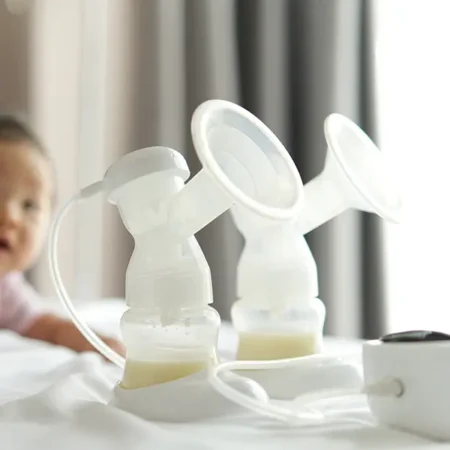Below are some of the exclusive pumping questions (and answers) that I am asked most often – everything from what to do about supply changes, different output from your breasts, and what to do if your nipples hurt.

This post may contain affiliate links, which means that if you click a link and take action, I may make a small commission at no additional cost to you. I only recommend products I love! More info here.
I am not pumping enough milk to feed my baby without supplementing. What can I do?
The first thing to look at is your pumping schedule. Ideally, you should be pumping for a total of 120 minutes a day; the number of times per day depends on the age of your baby (seven to ten times a day for a newborn, as few as three to four for a baby older than six months).
Sticking to a schedule if you aren’t already will really help your milk supply.
Note: By sticking to a schedule, I mean it’s important to get your sessions in, and have them be reasonably well spaced. It’s fine if they aren’t at the exact same time every day.
After that, there are a bunch of strategies that you can use to try to bring your supply up, such as power pumping, oatmeal, herbs like fenugreek or blessed thistle, teas, drinking more water, or prescription meds like domperidone. I have written about the basics of each of these here, as well as in greater detail in an e-book.
Here are some tips for getting more milk out of the sessions you do have:
My milk supply used to be fine, but it recently dropped. What is going on and what can I do about it?
If you used to make enough milk and then your supply went down, the prime culprits are:
- Hormones. Any chance that you’re getting your period back soon (have you noticed increased cervical fluid or have you felt crampy lately)? Or, is there any chance that you’re pregnant again?
- Schedule Changes. Have you changed your pumping schedule within the past month or so, maybe dropping a pumping session or changing the length of your sessions?
- Breast Health. Have you had mastitis or a clogged duct lately?
- Diet and Exercise. Have you recently started trying to lose weight or working out?
- Stress. Have you had any stressful changes in your life lately (aside from the obvious fact that you have a new baby)? For example, have you gone back to work, moved, or dealt with difficult family members?
Any of these can cause a supply drop, though sometimes a drop will happen for no discernible reason. The approach I would suggest depends on the reason. If it’s your period, you can try a calcium-magnesium supplement.
If you’ve recently changed your schedule, consider going back to the old schedule or power pumping to see if that helps. Additionally, make sure that you are pumping for a total of 120 minutes per day.
If you’ve had mastitis or a clogged duct recently, I would suggest pumping extra on the affected side – maybe even power pumping on that side – to see if that helps with bringing your supply back up.
When it might be a diet or exercise related issue, you will have to weigh (no pun intended) which is more important to you – the additional milk supply or your health and fitness goals. Eating a bit more may help with supply; at the same time, feeling good about yourself is important too.
For stress-related issues, do the best you can. You have a lot going on with having a new baby, exclusively pumping, and managing everything else in your life. Try to make pumping as relaxing as possible by doing something you enjoy while you pump, such as watching TV or reading a book, and don’t hesitate to seek help if you think you might be dealing with post-partum depression.
I’m exclusively pumping and my nipples hurt. I don’t have a clogged duct or mastitis. What should I do?
Nipple pain can happen for so many reasons, which makes it hard to figure out what the issue is.
Generally, my first suggestion with generalized nipple pain for exclusive pumpers is to try different flange sizes. This can be expensive, as it involves a lot of trial and error to keep buying new ones in the hope that you find one that fits and doesn’t hurt. You can try measuring your nipples (here are instructions) or try Pumpin’ Pals – they send you three sizes at once.
Once you switch flange sizes, give it a few days to see if the pain goes away, since the damage that was done by the old flange size will still need to heal. I would also suggest using some form of lubrication, such as coconut oil, to reduce the friction while you heal.
If it’s not the flanges, other things that I would look at are thrush (often described as a deep, shooting pain, sometimes with itching or burning), whether your bra fits correctly, and whether you have anything else that could be irritating your nipples (such as a diaper bag strap rubbing on them). Also, if you are a stomach sleeper, you might try switching to see if that helps.
I have a clogged duct or mastitis. What should I do?
If you have a clogged duct, read this; if you have mastitis, read this. I hope it clears up soon!
I want to drop a pumping session. Can I?
Yes, but you need to weigh the potential drop in supply with how much easier your life will be with one less pumping session. It’s hard to know what exactly will happen when you drop a pumping session; you may lose supply, stay the same, or even gain supply. I put together a flowchart to help you think through your options.
More information on how to drop pumping sessions is available here.
I want to drop a pumping session but I’m prone to clogged ducts and am afraid to go longer without pumping. What should I do?
In this situation, I would recommend gradually reducing the volume that you pump at the session that you’re dropping. Pump an ounce or so less each day at that session, until you’re down to one ounce. Then stop pumping at that time and respace your remaining sessions.
Make sure that you completely empty your breasts at the sessions before and after the session that you’re dropping.
I do not want to nurse and want to exclusively pump as soon as my baby is born. What should I do in the hospital? When should I start pumping?
I would plan on starting to pump once you get to the recovery room after delivery. The nurses should be able to provide you with a hospital-grade pump and show you how to use it.
In the beginning you make mostly colostrum, and colostrum is really hard to pump, so don’t worry if you’re not able to pump much for the first few days. (You might have better luck with a Haakaa or hand expression.)
Your milk should come in between days 2 and 4 postpartum, and unless you’re one of the lucky ones that can pump a lot of colostrum, I would plan on feeding your baby formula until it does.
Be prepared for the nurses to think that you’re crazy. If you tell them that you’re breastfeeding (which you are – exclusive pumping is breastfeeding) and have an uncomplicated vaginal delivery, they may assume you want to nurse after the birth. When you tell them you just plan to pump, they might tell you that won’t work, it’s impossible to keep up, etc. This is because many women that have pumped breast milk a) hate pumping, b) don’t respond well to the pump, and c) have never heard of exclusive pumping.
That’s okay though. Exclusive pumping is possible if it’s something you want to do! Don’t be afraid to ask for what you need.
(I wrote a longer post on this topic here.)
I get more milk from one side than from the other. Is this normal? What can I do to fix it?
It’s totally normal for one breast to produce more than the other; this is known as a “slacker boob.” My left side has always been the “money” side, producing probably 30% more than the right.
If you’d like to try to even it out, here are four things that you can do to try to fix it. However, it’s not necessary – there’s nothing wrong with getting more from one side than the other.
Ever since I started exclusively pumping, my nipples are permanently purple. Also, I have white stuff on them. Are they ever going to go back to the way they were?
This is very common, and yes, they will go back to the way they were before! The white stuff is dried milk (it’s not anything to be concerned about from a health perspective), and it won’t go away until you wean from the pump. (Oddly, I never had this with the babies that I nursed, so it seems to be a thing unique to exclusive pumpers.)
(Note: If your breasts change color to white after pumping and you have pain, that might be nipple vasospasms, which is an issue you may be able to address. The white stuff I mentioned above should not be painful.)
Hopefully, this post has answered your exclusive pumping questions! However, if it hasn’t, a great way to get answers to your exclusive pumping questions is to join the Facebook group – there are tons of exclusive pumpers who give great advice.
References- Bonyata, Kelly, IBCLC. “Fenugreek Seed for Increasing Milk Supply.” https://kellymom.com/bf/can-i-breastfeed/herbs/fenugreek/
- Flora, Becky, IBCLC. “Menstruation and Breastfeeding.” https://www.motherandchildhealth.com/breastfeeding/menstruation-while-breastfeeding/
- Barger, Jan, IBCLC. “How Many Days Will It Take for My Milk to Come in?” https://www.babycenter.com/404_how-many-days-will-it-take-for-my-milk-to-come-in_8897.bc












